Approach
Amblyopia is best diagnosed in early childhood when the visual system shows greatest plasticity.[10] Screening is key to diagnosis given that visual deficits can go undetected by children and their parents or caregivers.[33][34] See Screening.
Amblyopia is diagnosed when visual impairment is detected in the presence of amblyopia risk factors, such as strabismus, high or unequal refractive errors, or media opacities. See Criteria.
Amblyopia in the absence of these ocular risk factors is rare. If there is no obvious cause identified, an alternative diagnosis should be considered.
Primary ocular assessment: screening
Primary care providers (e.g., orthoptists, optometrists, and nurses) with access only to simple, inexpensive tests can perform screening for risk factors associated with the development of amblyopia.[34] The US Preventive Services Taskforce recommends screening tests throughout childhood, but particularly for children ages 3-5 years.[32][34] The UK National Screening Committee recommends screening for all children ages 4-5 years.[33][35][36][37]
History and exam
The history and exam should focus on amblyogenic risk factors, including:[1][21][32]
Manifest strabismus, 8 prism diopters (PD)
High, uncorrected refractive errors (anisometropia, hyperopia, astigmatism, myopia)
Myopia <-3.00 D (in children <4 years) or <-2.00 D (in children ≥4 years)
Media opacities >0.1 mm (e.g., congenital cataract, corneal opacity, nonclearing vitreous hemorrhage, and macular hemorrhage)
Severe ptosis or prolonged occlusion of one or both eyes
Prematurity
Developmental delay
Family history of amblyopia or strabismus (specifically family history of lazy eye, the need for spectacles before age 5 years, eye muscle surgery, or childhood patching)
Structural abnormality of the retina or vitreous
The history should also establish the presence of any parental or caregiver observations indicating visual deficit. Infants and preverbal children may lack the ability to fix and follow (i.e., fixate on faces or objects and track them). Nystagmus present before age 6 months can be idiopathic (e.g., normal structure of the visual system) or due to abnormal sensory input (e.g., retinal disorders or very high refractive errors).[38] Bilateral form-deprivation amblyopia causes bilateral sensory nystagmus.[1]
Older children may complain of blurred vision. But most older children with amblyopia, especially if unilateral, are unaware of their visual deficit. Eye strain is not a common presentation of amblyopia.[3]
Screening tests
The following screening tests may be performed by the primary care provider:[32]
Red reflex (Brückner) test
External inspection for structural abnormalities
Pupillary exam
The “fix and follow” test
Corneal light reflection
Visual acuity testing
Cover/uncover testing
Most verbal children over the age of 3 years can cooperate with visual acuity testing using an eye chart. The following eye charts are considered most accurate and acceptable by the World Health Organization: Sloan letters, Lea symbols, ''H, O, T, V'' letters, and the tumbling E chart.[1][32] Snellen letters and Allen figures are not considered as accurate.
Referral criteria for comprehensive ophthalmology assessment
A comprehensive assessment with an ophthalmologist is indicated if a child:[1][32][39]
Fails screening for any reason
Cannot be tested due to poor cooperation (e.g., children with learning difficulties)
Has a specific vision complaint requiring further assessment
Has risk factors for developing eye problems (e.g., developmental disorders, history of prematurity, family history of amblyopia or strabismus)
Comprehensive ophthalmology assessment
The content of the comprehensive ophthalmology assessment will depend on the clinical presentation and the results of any screening tests. An ophthalmologist seeks additional patient history, and further detail relating to established history, including:
Medical and drug history
Current eye problems and ocular history
Prenatal, birth, and perinatal history (including birth weight, substance abuse during pregnancy, previous hospitalizations, presence of developmental delay)
Family history of ocular conditions and relevant systemic conditions
Full review for relevant systemic conditions
Confirmatory cycloplegic exam is required for amblyopia risk factors that reach the following thresholds:[21]
media opacity >0.1 mm; manifest strabismus >8 PD;
anisometropia >1.25 dioptres (D);
hyperopia >4.00 D;
astigmatism >3.00 D (in children <4 years) or >1.75 D (in children ≥4 years); or
myopia <-3.00 D (in children <4 years) or <-2.00 D (in children ≥4 years).
Some tests are only performed before dissociating tests or applying cycloplegic agents.
Exam may include the following.[1][32][39][40][41][42][43]
Red reflex (Brückner) test: a direct ophthalmoscope exam should show a symmetric and bright yellow or red reflex in each normal pupil. The test can detect media opacities (diminished reflex or opacity within the reflex), strabismus (diminished reflex or absent reflex in the eye not directed towards the direct ophthalmoscope light), or high refractive error. An absent or irregular red reflex, or opacity within the reflex, can indicate visual axis obstruction (e.g., due to cataract or intraocular tumor). Red reflex testing should be undertaken before applying cycloplegic agents for pupillary dilation.
Visual acuity (monocular): verbal children are tested with multiple rather than single optotypes (the letters, numbers, geometric symbols, or pictures used in visual acuity tests).[40] Although amblyopic eyes see better when a single optotype is presented on a blank background, which can lead to overestimated visual acuity, some young children may get distracted or confused when presented with multiple optotypes. Crowding bars (i.e., stripes that surround an individual target to simulate multiple targets) may be used to avoid overestimating visual acuity. Subjective visual acuity testing is preferred if children can participate reliably, but instrument-based screening (e.g., photoscreening or autorefraction) may be useful in children who are unable to cooperate with testing.
Fixation pattern (central or eccentric): patients with a clear visual axis to the fovea and a normally positioned fovea will fixate with the center of the eye, whereas those with amblyopia, visual axis opacity, or displacement or disease of the fovea may fixate eccentrically, as if looking at an object from the side. Marked eccentric fixation is detected by observing the noncentral position of the corneal reflection in the amblyopic eye while the amblyopic eye fixates on a light. A patient with strabismus who can freely alternate fixation between eyes does not have amblyopia. Fixation can be graded by whether the nonpreferred eye holds fixation momentarily, for a few seconds (or to or through a blink), or does not hold fixation, or whether there is spontaneous alternation of fixation.
Stereopsis/binocular vision testing: sensorimotor fusion and coordinated binocular eye movements are sensitive to disruption by amblyopia.[1][42][43] Stereopsis (the perception of 3-dimensionality, or depth) is an important component of binocular vision testing, typically assessed using random dot-based global tests. The Randot Circles test presents contoured circles at 10 discrete disparity levels from 20 to 400 arcs and tasks the patient to choose which of 3 circles at each disparity level appears closest (a simple forced choice, with a lower arc second number indicating better stereopsis). Several other tests are also available depending on local practice and clinical need (e.g., TNO, Lang, Titmus, and Frisby). Additional testing for stereoacuity may include evaluation of sensory fusion (e.g., The Worth 4-Dot Test) and fusional motor vergence (e.g., prism bar or rotary prism testing).
Ocular alignment: assessed by corneal light reflex, cover/uncover, and alternate cover testing. The cover test measures tropias and total deviation in primary gaze using prisms. During assessment, the ophthalmologist pays special attention to anomalous head postures and ocular motility that may suggest refractive error, strabismus, or nystagmus. Ocular alignment testing should be undertaken before cycloplegia to avoid any temporary induced shifts in alignment.[Figure caption and citation for the preceding image starts]: Esotropia: left eye fixating (note decentered light reflection on right cornea)From the collection of Daniel J. Salchow, MD [Citation ends].
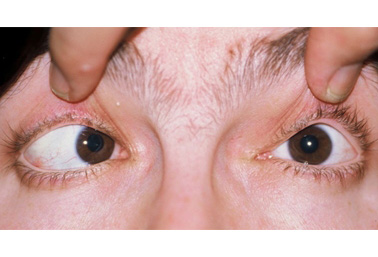
Pupillary exam: helps exclude ocular pathologies that may contribute to decreased vision (e.g., an abnormal pupillary response due to optic nerve hypoplasia or retinal pathology).
Anterior segment exam: helps exclude ocular pathologies that contribute to decreased vision (e.g., cataracts). Although these defects may be solely responsible for vision loss, coexistent amblyopia may explain a portion of the vision loss if they occur asymmetrically or monocularly. Typically performed with a slit lamp, but young children may require a portable slit lamp or magnifier.[Figure caption and citation for the preceding image starts]: Slit lampFrom the collection of Tina Rutar, MD [Citation ends].
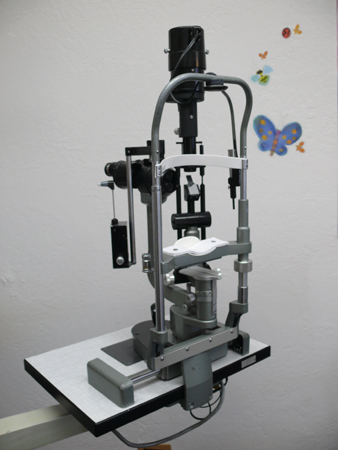 [Figure caption and citation for the preceding image starts]: Author performing slit lamp examFrom the collection of Tina Rutar, MD [Citation ends].
[Figure caption and citation for the preceding image starts]: Author performing slit lamp examFrom the collection of Tina Rutar, MD [Citation ends].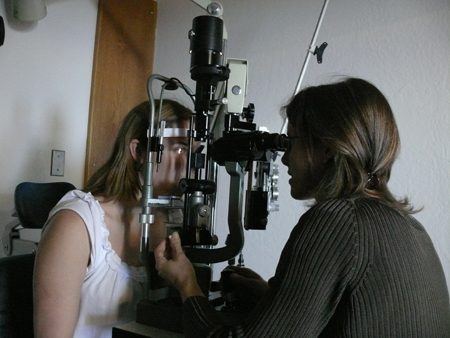 [Figure caption and citation for the preceding image starts]: Portable slit lampFrom the collection of Tina Rutar, MD [Citation ends].
[Figure caption and citation for the preceding image starts]: Portable slit lampFrom the collection of Tina Rutar, MD [Citation ends].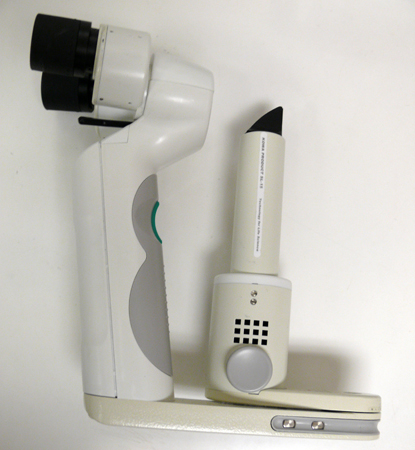
Cycloplegic retinoscopy: an essential part of the complete ophthalmic exam of a child. Many causes of amblyopia can only be assessed with a reliable cycloplegic retinoscopy. Eye drops are used to dilate the pupil and relax the ciliary muscle: cyclopentolate 0.2%/phenylephrine 1% for infants and cyclopentolate 1% (occasionally with phenylephrine 2.5%) for children ages 1 year and older. A relaxed ciliary muscle impairs the strong focusing ability of the child's eye, allowing the ophthalmologist to objectively determine the child's refractive state. While performing retinoscopy, the ophthalmologist also assesses the quality of the light reflex to ensure that nothing in the visual axis interferes with a clear image reaching the retina.[Figure caption and citation for the preceding image starts]: Retinoscope with plus and minus spherical lenses for refractionFrom the collection of Tina Rutar, MD [Citation ends].
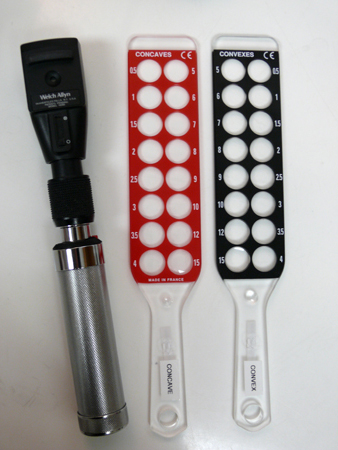
Dilated fundoscopic exam: helps exclude ocular pathologies that may contribute to decreased vision (e.g., macular lesions). Although these defects may be solely responsible for vision loss, co-existent amblyopia may explain a portion of the vision loss if they occur asymmetrically or monocularly. Fundoscopic exam is preferably undertaken using an indirect ophthalmoscope and condensing lens. It is typically performed after cycloplegic retinoscopy when there is adequate pupillary dilation.[Figure caption and citation for the preceding image starts]: Indirect ophthalmoscope with 28-diopter lens for performing fundus examFrom the collection of Tina Rutar, MD [Citation ends].
 [Figure caption and citation for the preceding image starts]: Author performing indirect ophthalmoscopyFrom the collection of Tina Rutar, MD [Citation ends].
[Figure caption and citation for the preceding image starts]: Author performing indirect ophthalmoscopyFrom the collection of Tina Rutar, MD [Citation ends].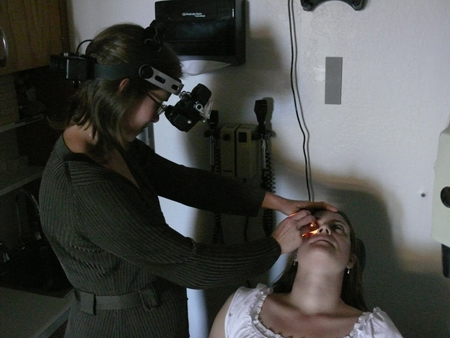
Emerging tests
The use of visual evoked potentials (VEPs) is an emerging test that may be used to aid diagnosis in uncertain cases.[44][45][46][47][48] Patterns are recorded using occipital electrodes that detect activity in the visual cortex while visual stimuli are presented to the eyes. Studies using different types of VEPs (orientation-specific, steady-state motion, multifocal, pattern, and sweep) show that these may be used to predict response to amblyopia therapy.[45][46][47][48]
Use of this content is subject to our disclaimer